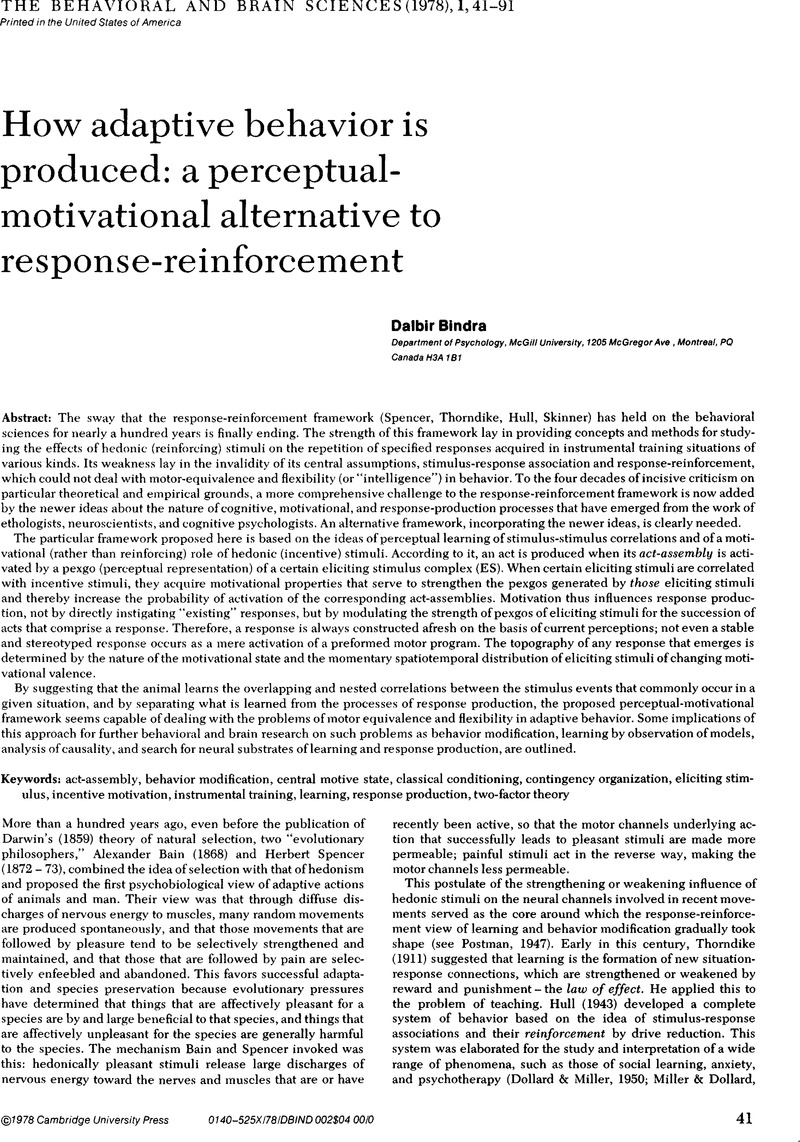No CrossRef data available.
Article contents
Omnipotent pexgos and the goddess parsimony
Published online by Cambridge University Press: 04 February 2010
Abstract
An abstract is not available for this content so a preview has been provided. Please use the Get access link above for information on how to access this content.

- Type
- Open Peer Commentary
- Information
- Copyright
- Copyright © Cambridge University Press 1978
References
REFERENCES
Azrin, N. H. and Hake, D. F.Positive conditioned suppression: Conditioned suppression using positive reinforcers as the unconditioned stimuli. Journal of the Experimental Analysis of Behavior, 1969, 12:167–173.CrossRefGoogle ScholarPubMed
Ellison, G. D. and Konorski, J.Separation of the salivary and motor responses in instrumental conditioning. Science, 1964,146:1071–1072.CrossRefGoogle ScholarPubMed
Fedorov, V. K.Physiological characteristics of the motor analyzer in dog. Leningrad: Medgiz, 1955 (in Russian).Google Scholar
Harvey, R. A. The effect of first- and second-order appetitive conditioned stimuli on food-reinforced bar pressing. M.A. Thesis, Dept. of Psychology, San Diego State University. 1977.Google Scholar
Jankowska, E. and Soltysik, S. Motor conditioned reflexes established from unconditioned motor reflexes reinforced by food. In: Central and Peripheral Mechanisms of Motor Activity in Animals. Moscow: Izd. Akad. Nauk SSSR, 1960,61–69. (in Russian)Google Scholar
Kelly, D. D.Long-term pre-reward suppression in monkeys unaccompanied by cardio-vascular conditioning. Journal of the Experimental Analysis of Behavior, 1973,20:93–104.CrossRefGoogle Scholar
Konorski, J.Integrative activity of the brain. Chicago: University of Chicago Press, 1967.Google Scholar
Konorski, J.Classical and instrumental conditioning: The general laws of connections between “centers.” Ada Neurobiologiae Experimentalis, 1974,34:5–13.Google ScholarPubMed
Konorski, J. and Miller, S.L'influence des excitateurs absolus et conditionnels sur les reflexes conditionnels de l'analysateur moteur. C. R. Soc. Biol. 1930,104:911–913.Google Scholar
Kupalov, P. S. Involuntary reactions to conditioned food stimuli. In: Trudy Ob'edinennoi Sessii, Posv. 10-letiu so dnia smerti I.P. Pavlova. Moscow: Izd. AMN SSSR, 1948,67–78.Google Scholar
LoLordo, V. M., McMillan, J. C. and Riley, A. L.The effects upon food reinforced pecking and treadle-pressing of auditory and visual signals for response-independent food. Learning and Motivation, 1974, 5:24–41.CrossRefGoogle Scholar
Meltzer, D. and Brahlek, J. A.Conditioned suppression and conditioned enhancement with the same positive UCS: An effect of CS duration. Journal of the Experimental Analysis ofBehavior, 1970,13:67–73.CrossRefGoogle ScholarPubMed
Miczek, K. A. and Grossman, S. P.Positive conditioned suppression: Effects of CS duration. Journal of the Experimental Analysis of Behavior, 1971, 15:243–247.CrossRefGoogle ScholarPubMed
Miller, S. and Konorski, J.Sur une forme particuliere des reflexes conditionnels. C. R. Soc. Biol 1928,99:1155–1157.Google Scholar
Miyata, Y. and Soltysik, S.Effect of food-satiation and food-deprivation upon the conditioned reflexes established by the Ellison-Konorski separation procedure. Ada Neurobiologiae Experimental, 1971, 31:47–58.Google ScholarPubMed
Pavlov, I. P.The reply of a physiologist to psychologists. Psychological Review, 1932,39:91–127.CrossRefGoogle Scholar
Pavlov, I. P.Physiological mechanism of the so-called voluntary movements. Trudy Fiziol. Lab. I.P. Pavlova, 1936,6:115–118. (in Russian).Google Scholar
Soltysik, S.Post-consummatory arousal of drive as a mechanism of incentive motivation. Ada Neurobiologiae Experimental, 1975,35:447–474.Google ScholarPubMed
Soltysik, S. “Operant sensitization” and some remarks on unit recording in conscious animals. In: Brain Mechanisms in Mental Retardatio UCLA Forum in Medical Science, Vol. 18. Brain, N. A. Buchwald and Brazier, M. A. B. (Eds.) New York: Academic Press, 1975, pp 373–377.Google Scholar
Soltysik, S., Konorski, J., Holownia, A. and Rentoul, T.The effect of conditioned stimuli signalling food upon the autochthonous instrumental responses in dogs. Act a Neurobiologiae Experimentalis, 1976, 36:277–310.Google ScholarPubMed
Yakovleva, V. V.Establishment of conditioned reflexes to a complex kinesthetic stimulus (to the so-called involuntary movements). Zhurnal Visshei Nervnoi Deiatel'nosti, 1952, 2:305–316 (in Russian).Google Scholar


